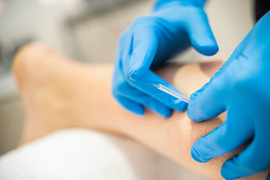Greetings
Welcome to the March newsletter from Impact Physio & Sport Clinic.
Have you heard of Intramuscular Stimulation (IMS)?
IMS is a common therapeutic approach that provides relief for individuals suffering from persistent nerve pain. Read on to learn more about the benefits of combining physiotherapy exercises with IMS.
Neuropathic pain is characterized by chronic muscle pain that develops due to hypersensitive nerves that continuously transfer signals.
Nerves transmit pain signals to alert individuals that there is a physical problem that needs to be resolved. Under normal circumstances, the pain will go away once the inflammation that is causing the problem subsides. In the case of neuropathic pain (also called hypersensitive nerve pain), however, inflammation or sensitization may persist for several months, causing hypersensitive nerves that trigger constant deep muscle pain. Fortunately, if the underlying issue is addressed in a timely manner, the affected nerves may be able to fully recover their original function.
One effective way to address neuropathic pain is to combine an approach called intramuscular stimulation (IMS) with therapeutic exercises. IMS, which is also called dry needling, helps desensitize inflamed nerves while restoring flexibility and more fluid movement patterns. This method involves the use of thin acupuncture needles that ‘deactivate’ trigger points and relieve muscle tension, both of which lead to reduced pain or complete pain relief. It is called ‘dry’ needling because no form of medication or pain-relieving substance is injected through the needle.
This technique is particularly effective for those persistent trigger points and tension spots that don’t seem to respond to massage therapy, exercise or spinal manipulation in a lasting way.
|
IMS may sometimes be confused with acupuncture, but they are different. The main goal of acupuncture is the restoration of energy flow, balance, centering, and relaxation, with needles being placed along specific meridian lines on the body as defined in eastern medicine.
|
 |
IMS, on the other hand, targets the effects of persistent abnormal nerve signaling at the muscle level in order to restore mobility, reduce pain, and directly influence nervous system function.
IMS also enhances blood flow as muscle tightness can reduce blood circulation and oxygen delivery. Its ability to improve circulation, boost collagen production, and support protein formation promotes healing as well. Accordingly, IMS has demonstrated positive outcomes for people suffering from low back and neck pain, tendonitis, chronic tension headaches, plantar fasciitis (heel pain), carpel tunnel syndrome, and rotator cuff impingement (shoulder pain), to name a few.
If you’ve been dealing with constant aches, deep within your muscles that have persisted for several months, it may be time to speak with a physiotherapist about combining IMS and therapeutic exercises. Some individuals experience immediate relief after undergoing IMS, while others may need repeated sessions to begin to notice improvement. To promote progress, a physiotherapist will perform a thorough examination of each individual's need to determine the optimal frequency, intensity, and duration of IMS sessions.
An IMS regimen that specifically targets sensitized nerves, restricted blood flow, and delayed tissue healing while promoting flexibility and muscle strengthening through guided exercise may be just what you need to start really enjoying life again. Call today to speak with one of the physiotherapists at Impact Physio & Sport Clinic to see how you can get started.
References
1. Jung W, et al. The effect of Gunn's intramuscular stimulation for postherpetic neuralgia -A report of 4 cases. Korean J Anesthesiol. 2010;58(3):311-317.
2. Dunning J, et al. Dry needling: a literature review with implications for clinical practice guidelines. Phys Ther Rev. 2014 Aug; 19(4): 252-265.
3. Tough EA, White A. Effectiveness of acupuncture/dry needling for myofascial trigger point pain–a systematic review. Phys Ther Rev. 2011;16(2):147-54.
4. Tough EA, White AR, Cummings TM, Richards SH, Campbell JL. Acupuncture and dry needling in the management of myofascial trigger point pain: a systematic review and meta-analysis of randomised controlled trials. Eur J Pain. 2009;13(1):3-10.
5. Gunn CC, Milbrandt WE, Little AS, Mason KE. Dry needling of muscle motor points for chronic low-back pain: a randomized clinical trial with long-term follow-up. Spine (Phila Pa 1976). 1980;5(3):279-91.